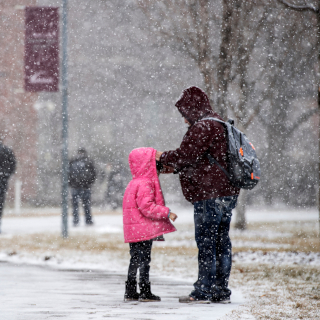Communication Skills - For Families
What is it?
Communication is giving, receiving, and sharing information between two or more people. Communication happens in many forms:
- Spoken — between individuals/groups, public addresses from leaders, or daily casual conversations
- Written — text messages, emails, formal letters, or on adaptive devices
- Listening — actively listening when being spoken to instead of waiting to respond or listening for meaning
- Reading — messages from casual text reminders to formal communication
- Non-verbal — unspoken cues taken from a person’s body language and the physical way they interact with others
Communication should always strive to be clear, understandable, and respectful.
Why does it matter?
The key to all relationships is trust and understanding. One of the essential skills needed to achieve these components is good communication. Good communication is clear, unbiased, and presented in a manner accessible to the working population. Good communication also focuses on helping children and families share their experiences, expectations, needs, and goals for our time together. When working with people from groups, you don't belong to. You should expect the cultural norms and practices around communication to be different. These differences stem from cultural values and standards and should not be considered invalid.
Practice strategies that work
When working with colleagues and organizations, try to be:
Clear
- Know the “why” or what you are trying to accomplish in the conversation.
- Stay on the message – what do you want others to most understand.
- Avoid words, acronyms, and phrases that others may not understand.
- Avoid “Uh” “Ummmm” – Slow down and take natural pauses or breaths in place of filler words.
Unbiased
- Use gender-neutral phrases, such as, instead of “Hey guys,” try “Hey everyone.”
- Avoid the use of words like normal or typical.
- Avoid using identifying characteristics when it is not relevant to the conversation.
- When in doubt, respectfully ask people how they want to be identified (see Inclusive Language Guides such as this one from Oregon Health and Science University for more information or our courses on Culture).
Accessible
- Use smaller, more common words
- Leave room for others to ask questions – avoid one-sided conversations.
- Ask if others are following you or what you are saying makes sense.
Communication is a lifelong skill, to learn new skills or refine your skills, also try:
Active listening
- Maintain eye contact and use brief physical and verbal affirmations you are listening.
- Clarify understanding, such as, “What did you mean when you said …?”.
- Restate what you are hearing to seek validation you understand by saying phrases such as, “So you feel that…” or “Are you trying to say…”.
- Don’t interrupt, and encourage communication.
Nonverbal
- Be aware of your facial expression. Video communication has provided us with a new opportunity to monitor ourselves.
- Be aware of the tone of your voice and non-verbal communication, such as grunts and sighs.
- Nod in agreement to show you are listening.
- Use culturally appropriate touch with consent.
Seek feedback
- Be prepared to feel uncomfortable. And spend some time thinking about what you would like to improve on or get validation you are doing well.
- Ask coworkers, supervisors, and clients for feedback on your performance in real-time.
- Pose specific questions, such as, “What is one thing I could do to improve our communication/meetings?” or “How did that go from your perspective?”
Additional Resources
Communication Skills for Social Workers As a social worker, the way you interview a client can profoundly impact the quality of the responses you get.
COVID-19 Tips: Building Rapport with Youth via Telehealth A tipsheet for clinicians working with youth during the COVID-19 pandemic: Ways to build rapport during telehealth.
Tips for Family Services Staff Working Remotely with Families These tips can be applied during public health emergencies, natural disasters, and other crises.
Improving Family Communications Quick tips to support families in improving their communication.
Find these books at your local library.
Difficult Conversations: How To Discuss What Matters Most by Douglas Stone
Just Listen: Discover the Secret to Getting Through to Absolutely by Mark Goulston
Daring Greatly: How the Courage to Be Vulnerable Transforms the Way We Live by Brené Brown
Say What You Mean: A Mindful Approach to Nonviolent Communication by Oren Jay Sofer
Why Are We Yelling?: The Art of Productive Disagreement by Buster Benson
We Need to Talk: How to Have Conversations That Matter by Celeste Headlee
De-escalating Children's Anger: Using the RESPECT Approach to End the Power Struggle and Promote Self-Responsibility by Jeffrey Shostack
Roots of Miscommunication This video shows how misunderstandings can escalate when communicating, particularly with emails and texts.
Celeste Headlee: 10 ways to have a better conversation Celeste shares 10 useful rules for having better conversations. "Go out, talk to people, listen to people," she says. "And, most importantly, be prepared to be amazed."
The Power of Vulnerability Brene Brown shares a deep insight from her research, one that sent her on a personal quest to know herself as well as to understand humanity.
Active Listening Quick tips on being an active listener.
Say This, Not that Help increase communication with tweens and teens.
The Family Table Families share stories of the reality of substance use, family violence, mental health disorders, relationship problems, and other challenges.
Improving Communication Skills from Coursera
Google Translate A free tool that has over 90 languages to support working with non-English speakers. Google Translate also can translate handwriting and written signs.
**When using video chats, text messages, or other tools to communicate with families, be sure they are encrypted to protect private information.
